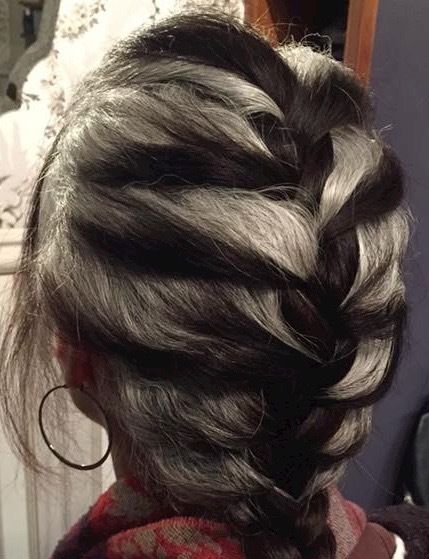
Managing the transition, six months in.
I didn’t like the sound of it when, in my thirties, I overheard someone describe my hair as “salt and pepper.” In fact, it bothered me so much I started coloring my hair. But a few years later, busy with kids, work, and some medical issues, my priorities changed and I abandoned the routine.
I had internalized the values of our youth-obsessed culture for decades, and so felt a need to explain this decision—why wouldn’t I want to look as young as I could? I was living in New Hampshire at the time and wrote a regular column for a local paper. About my decision to go gray at age forty, I wrote, “I feel like I’ve broken free from an unnecessary, never-ending chore. And though I sometimes miss my dark hair, I don’t miss that wave of nagging self-consciousness that comes every few weeks when the roots begin to peek through. It’s a trade-off that seems worth it.”
My priorities—and my perception of my graying hair—changed again after my divorce seventeen years ago. Back in the dating world and looking for fulltime work, gray hair seemed like a barrier to two significant goals I needed to achieve in order to start the next chapter of my life. And so, acutely aware of what the culture demands of women, I resumed the ritual. Though still a never-ending chore, it now seemed necessary. Once again my life was punctuated by the wave of nagging self-consciousness that returned with my roots every three weeks. For close to two decades, I dutifully made the appointments for my color and two-hour sits.
The salon was a pleasant backstage, a place for relaxation and downtime. I’d bring a book or thumb through magazines I enjoyed but would never otherwise have read. I’d bring work, fleshing out ideas or drafting reports while the alchemy transpired on my head. With my Blackberry and then my iPhone, I could more easily make use of this time, sending and responding to emails, reading ebooks, or catching up on news or social media.
I could push the next appointment out to four or five weeks if there was nothing especially important or highly public coming up. When special events were not in sync or came up suddenly, the next appointment might be in under three weeks, or I’d figure out how to split the difference, weighing the relative importance of various commitments, taking into account what else was on my calendar. I spent an absurd amount of mental energy on the planning that accompanies this ritual, separate and apart from the tens of thousands of dollars I spent on the color itself.
Last August, on my 60th birthday, I gave myself an important gift. I decided to stop coloring my hair. Always an introspective person, the months leading up to this milestone birthday were a period of even greater contemplation. What have I accomplished and what do I still want to achieve? How will my children and grandchildren remember me? What can I do, in my time remaining, to make the world a better place? Is there still time for me to outgrow my shortcomings and be a better person?
Feeling a newfound commitment to simplicity and authenticity in this final third of my life, the ritual of coloring my hair seemed, like many rituals do upon close examination, devoid of purpose. If my gray hair was going to be a barrier to male companionship and professional opportunity, well, so be it. I would connect where I was meant to connect.
That said, I knew the decision would be of greater social and psychological consequence than in it was in my forties. Indeed, rejecting the cultural imperative to appear young requires more fortitude and soul-searching when you’re no longer young. Was I ready to come out as “old?” Was I ready to risk being invisible or perceived as less vital? I reluctantly realized that I was now pushing back against six decades of cultural messages about aging and gray-haired women that had snuck into my consciousness. But I don’t feel old and, along with many of my age peers, reject these obsolete caricatures that don’t describe who I am or how I live my life. Though it’s become trite to say, boomers changed cultural attitudes in the ‘60s and we continue to do so today.
My colorist advised me to gradually go lighter, maybe changing to a “double process” for a year or so. But adding complexity to a ritual in order to leave it behind made no sense to me and I decided to go cold turkey.
For many months, the contrast of dark brown and white looked weird; tacky and unkempt perhaps. But my commitment to living my priorities made it easier to transcend the familiar wave of nagging self-consciousness.
The 2016 election also became a factor. Candidate Trump’s focus on women’s looks and the re-emergence of fifties-era misogyny during the presidential campaign made my decision easier. Six months into my hair journey and disgusted by the climate created by our Misogynist-in-Chief, Mitch McConnell’s silencing of Elizabeth Warren on the Senate floor encouraged me further. My decision to go gray began to feel like something bigger than a decision to live my priorities; it began to feel like an act of resistance.
My transition has made me more aware of the hair coloring practices of older women in the public eye. And while I firmly believe that women of any age should do what feels right for them, it bothers me that powerful, accomplished women such as Ruth Bader Ginsberg, Nancy Pelosi, Dianne Feinstein, Elizabeth Warren and Hillary Clinton have to work hair coloring into their busy schedules—a cultural demand not imposed on their male colleagues.
It’s been almost a year since I last colored my hair and I’m still getting comfortable with my new look and my new decade. I never actually lied about my age, yet I now feel like I’m telling the truth.
